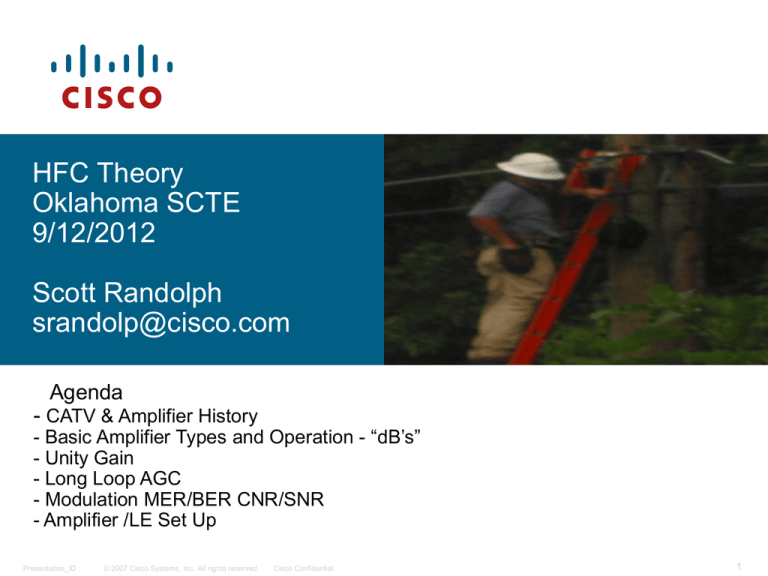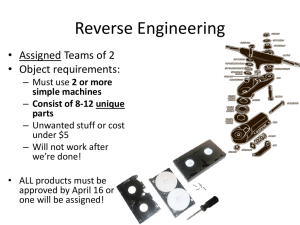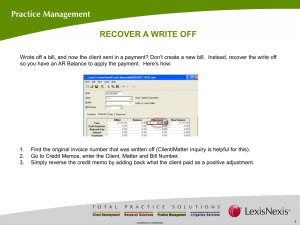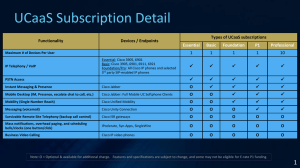
HFC Theory
Oklahoma SCTE
9/12/2012
Scott Randolph
srandolp@cisco.com
Agenda
- CATV & Amplifier History
- Basic Amplifier Types and Operation - “dB’s”
- Unity Gain
- Long Loop AGC
- Modulation MER/BER CNR/SNR
- Amplifier /LE Set Up
Presentation_ID
© 2007 Cisco Systems, Inc. All rights reserved.
Cisco Confidential
1
CATV Then
Vacuum Tube Technology: the Jerrold HPM-12
Channel 12 Amplifier
Vacuum Tube Technology: the Jerrold 12Channel SDA-4 Super Distribution Amplifier
Typical Frequency Plan, 12-Channel System,
One Way (1948-1989)
Long Cascades
Poor Powering
Multiple Headends
Poor or No Designs
Limited Resources
Presentation_ID
© 2007 Cisco Systems, Inc. All rights reserved.
Cisco Confidential
2
CATV Now
Fiber Optics
Short Cascades
Standby Power Supplies
Increased System Reliability
System Monitoring
Return Path
Presentation_ID
© 2007 Cisco Systems, Inc. All rights reserved.
Cisco Confidential
3
CATV Amplifier Timeline
Presentation_ID
© 2007 Cisco Systems, Inc. All rights reserved.
Cisco Confidential
4
Push Pull Amplifiers
VCC
Distortion Canceling
Fs
Splitter-Inverter
o
180
VCC
Presentation_ID
© 2007 Cisco Systems, Inc. All rights reserved.
Cisco Confidential
5
Power Doubling Amplifiers
Push
Pull
Stage
High Gain
Reduced
Distortions
Push
Pull
Stage
Presentation_ID
© 2007 Cisco Systems, Inc. All rights reserved.
Cisco Confidential
6
Power
Any doubling of power is represented by
+3dB Gain
Any Halving of power is represented by
-3dB Loss
Push
Pull
Stage
-3dB
X
Push
Pull
Stage
Does This explain why I cautioned of a 3dB
loss at the output of a Amplifier??
Presentation_ID
© 2007 Cisco Systems, Inc. All rights reserved.
Cisco Confidential
7
dBmV & dB
“dBmV” is the unit of measurement for RF
energy
in a Cable Television system.
0 dBmV = 1000 mV / 75 W
“dB” is a ratio of two power levels.
It indicates the Gain or Loss of a device.
“dB’ is 10 times a power ratio and 20 times a voltage ratio.
dB = 10Log P1 / P2
and
Power = E2/R
dB = 10Log (E2out/R / E2in/R )
dB = 10Log (Voltage Ratio)2 or
dB = 20Log (Voltage Ratio)
Presentation_ID
© 2007 Cisco Systems, Inc. All rights reserved.
Cisco Confidential
8
What is “0” dBmV??
The FCC minimum RF level to a consumers
device in the home is 0dBmV.
0 dBmV is 1000 micro volts across 75 ohms.
How much power is represented at 0dBmV?
Power = V2/R, = (1000x10-6)2 / 75 =
Pref = 13.33x10-9 Watts
THIRTEEN BILLIONTHS OF A WATT
Example: Average Hair Dryer will draw 1000 to 1500 Watts
Presentation_ID
© 2007 Cisco Systems, Inc. All rights reserved.
Cisco Confidential
9
Amplifier Accessories
- Equalizers
-Attenuators
Presentation_ID
© 2007 Cisco Systems, Inc. All rights reserved.
Cisco Confidential
10
Equalizer Function
Effect of Cable
20 dBmV
10 dBmV
0 dBmV
1GHz
50 MHz
0 dB
Presentation_ID
Combined
Results
50 MHz
10 dB
20 dB
10 dBmV
Effect of Equalizer
50 MHz
© 2007 Cisco Systems, Inc. All rights reserved.
1GHz
Cisco Confidential
1GHz
The equalizer response pattern
compliments the response pattern
of the cable to produce a flat broadband output signal.
11
Attenuator Function
20 dBmV
20 dBmV
10 dBmV
10 dBmV
0 dBmV
50 MHz
1GHz
0 dBmV
50 MHz
1GHz
This Graph Represents a 10dBm Pad
An attenuator reduces the level of the signal equally at all frequencies.
An attenuator at the input of an amplifier directly affects C/N.
Presentation_ID
© 2007 Cisco Systems, Inc. All rights reserved.
Cisco Confidential
12
Low
High
Forward Path Set Up
DC
TP
Post
Amp
Interstage
Atten.
ALSC
Option
Plug In
Response Interstage
Equalizer Slope Eq.
Inter
Stage
Amp
High
Pre
Amp
Dist
EQ
Low
Input Input
EQ
Atten
AT
ATT
Pad
Low
DC
TP
High
Pad
Post
Amp
DC
TP
Signal
Director
DC 4-8-12
Return
Combiner
-5 dB
Pad
Pad
Presentation_ID
© 2007 Cisco Systems, Inc. All rights reserved.
Cisco Confidential
Low
Return
Amp
High
Pad
DC
TP
13
Effects of Over Equalization
Reference
Level
50 MHz
1 GHz
The equalizer response pattern is Designed to
Compliment the response pattern of the cable.
When too Much Equalization is used the Familiar “Hump”
Is created
Presentation_ID
© 2007 Cisco Systems, Inc. All rights reserved.
Cisco Confidential
14
Unity Gain
- Forward Unity Gain
- Reverse Unity Gain
- Long Loop AGC
Presentation_ID
© 2007 Cisco Systems, Inc. All rights reserved.
Cisco Confidential
15
Forward Path Unity Gain
IN
+10 dBmV
(0 dB input atten.)
OUT
+32 dBmV
IN
+16 dBmV
(6 dB input atten.)
OUT
+32 dBmV
1485'
OUT
+32 dBmV
945'
2 dB
8 dB
22 dB @ 750 MHz
14 dB @ 750 MHz
Unity gain in the downstream path exists when the
amplifier’s station gain equals the loss of the cable and
passives before it.
The third amplifier (far right) is fed by a span that has 14 dB of
loss in the cable and another 2 dB of passive loss in the
directional coupler, for a total loss of 16 dB. In order for the total
loss to equal the amplifier’s 22 dB of gain, it is necessary to install
a 6 dB input attenuator at the third amplifier.
745'
For example, the 22 dB loss between the first and second amplifier
is all due to the cable itself, so the second amplifier has a 0 dB input
attenuator. Given the +10 dBmV input and +32 dBmV output, you
can see the amplifier’s 22 dB station gain equals the loss of the
cable preceding it.
11 dB @ 750 MHz
In this example, the gain of each downstream amplifier is 22 dB.
The 750 MHz losses preceding each amplifier are 22 dB as well.
IN
+13 dBmV
(3 dB input atten.)
In the downstream plant, the unity gain reference point is the
amplifier output.
OUT
+32 dBmV
Presentation_ID
© 2007 Cisco Systems, Inc. All rights reserved.
Cisco Confidential
16
Reverse Path Unity Gain
OUT
+24 dBmV
(11 dB output atten.)
IN
+20 dBmV
OUT
+25 dBmV
(10 dB output atten.)
IN
+20 dBmV
1485'
IN
+20 dBmV
945'
2 dB
8 dB
4 dB @ 30 MHz
3 dB @ 30 MHz
Unity gain in the upstream path exists when the
amplifier’s station gain equals the loss of the cable and
passives upstream from that location.
The third amplifier (far right) feeds a span that has 3 dB of loss
in the cable and another 2 dB of passive loss in the directional
coupler, for a total loss of 5 dB. In order for the total loss to
equal the amplifier’s 15 dB of gain, it is necessary to install a 10
dB output attenuator at the third amplifier.
745'
For example, the 4 dB loss between the first and second amplifier
is all due to the cable itself, so the second amplifier has an 11 dB
output attenuator. The amplifier input is +20 dBmV, making the
reverse amplifier module output +35 dBmV. In order to obtain
unity gain and the correct input at the first upstream amplifier
location, an 11 dB output attenuator is required at the second
amplifier’s reverse output so that the total loss equals the gain of
the amplifier.
2 dB @ 30 MHz
In this example, the gain of each reverse amplifier is 15 dB.
The 30 MHz losses following each amplifier are 15 dB as well.
OUT
+30 dBmV
(5 dB output atten.)
IN
+20 dBmV
In the upstream plant, the unity gain reference point is the
amplifier input.
Presentation_ID
© 2007 Cisco Systems, Inc. All rights reserved.
Cisco Confidential
17
Changes to the Return Path
Long Loop AGC
Changing things in one part of the system may result in undesirable changes
in another part of the system.
18 to 21dBmV
RF Input
US Ports
A
Up to -10dB
Optical Loss
-7 to -20dBm
Optical Input
Pad N
US Ports
30 to 35 dBmV
RF Output
Pad
1310nm
Optical Tx
Upstream
RF Amplifier
A1
-10 to +3dBm
Optical Output
HFC Node
Upstream
Rx
Headend
Combining
A1
A2
A2
Upstream
HFC
Network
Long Loop AGC
An
Pad4
Pad3
Pad2
Pad1
Headend
Network
An
n+1
n+1
Subscriber Network
Appliances (clients)
18 to 21dBmV
RF Input
4
Downstream
HFC Network
Application #1
US
DS
Downstream Signaling
Application #1
DS
US
Application #2
US
DS
Downstream Signaling
Application #2
DS
US
Application #3
US
DS
Downstream Signaling
Application #3
DS
US
Application #4
US
DS
Downstream Signaling
Application #4
DS
US
Headend
Equipment
(servers)
-10 to 0 dBmV
RF Input
50 to 65 dBmV
RF Ouput
Presentation_ID
© 2007 Cisco Systems, Inc. All rights reserved.
Cisco Confidential
18
Long Loop AGC Cause and Effect
Consider what will happen if the value of the attenuator
at the reverse optical transmitter is increased. This will
initially reduce the RF levels through the optical link, the
splitter/combiner network in the hub/headend, and the
CMTS upstream input. The CMTS will react to this
decreased level by telling the cable modem to increase
its upstream RF transmit power. The power in the
coaxial plant will increase until the original level at the
CMTS input port is achieved. The net result of
increasing the optical transmitter attenuator will not be
a decrease in the RF levels further upstream, but rather
an increase in RF levels at the cable modem output
and in the RF plant!
Presentation_ID
© 2007 Cisco Systems, Inc. All rights reserved.
Cisco Confidential
19
Conclusions
Return system is a loop
Unity Gain Upstream and Downstream
Changes anywhere in the loop can effect the
performance of the network
Modem outputs can vary from manufacturer to
manufacturer(Levels are reduced as higher Modulation Schemes are
used)
Once the return laser is setup DON’T TOUCH IT
Changing the drive levels can effect the window of operation of the laser
Work as a team to diagnose system problems
Presentation_ID
© 2007 Cisco Systems, Inc. All rights reserved.
Cisco Confidential
20
Differing Modulation Types
And Power Levels
CNR vs SNR
MER/BER
Presentation_ID
© 2007 Cisco Systems, Inc. All rights reserved.
Cisco Confidential
21
Per Carrier Power vs. Composite Power
As you add more carriers to
the return path the composite
power to the laser increases.
To maintain a specific amount
of composite power into the
transmitter the carrier power
must be reduced.
When modulation schemes
are changed the composite
power into the transmitter
changes.
FSK
BPSK
QPSK
QAM-16
QAM-32
QAM-64
Video
Rel Power
-22.6
-19.0
-19.0
-12.1
-8.2
-6.0
0.0
The higher the order of
modulation the more energy the
channel contains.
Presentation_ID
© 2007 Cisco Systems, Inc. All rights reserved.
Cisco Confidential
22
Changing Modulation Type
21dBmv
FSK
Modulation
Power into
Transmitter: 24 dBmV
21dBmv
QAM 16
Modulation
Presentation_ID
© 2007 Cisco Systems, Inc. All rights reserved.
Cisco Confidential
Power into
Transmitter: 34 dBmV
23
Changing Modulation Type
21dBmv
QAM 16
Modulation
Power into
Transmitter: 34 dBmV
21dBmv
QAM 64
Modulation
Presentation_ID
© 2007 Cisco Systems, Inc. All rights reserved.
Cisco Confidential
Power into
Transmitter: 40 dBmV
24
CNR Carrier to Noise
CNR is a pre-detection measurement performed on RF
signals
Raw carrier power to raw noise power in the RF transport
path only—say, a coaxial cable distribution network or a
standalone device/converter or HE hetrodyneprocessor
Ideal for characterizing network impairments
Presentation_ID
© 2007 Cisco Systems, Inc. All rights reserved.
Cisco Confidential
25
SNR Signal to Noise
•SNR is a pre-modulation or post-detection
measurement performed on baseband signals
Includes noise in original signal, transmitter or
modulator, transport path, and receiver & demodulator
Ideal for characterizing end-to-end performance—the
overall signal quality seen by the end user
Presentation_ID
© 2007 Cisco Systems, Inc. All rights reserved.
Cisco Confidential
26
MER Modulation Error Ratio
The ratio of average signal constellation power to average
constellation error power
Presentation_ID
© 2007 Cisco Systems, Inc. All rights reserved.
Cisco Confidential
27
BER
=
number of errors / total number of bits sent
BER Bit Error Ratio
BER = Number of Errors/Total Number of Bits Sent
The rate is typically expressed as 10 to the negative power. For example, four
erroneous bits out of 100,000 bits transmitted would be expressed as 4 x 10-5, or the
expression 3 x 10-6 would indicate that three bits were in error out of 1,000,000
transmitted. BER is the digital equivalent to signal-to-noise ratio in an analog system.
Noise is the main enemy of BER performance.
Presentation_ID
© 2007 Cisco Systems, Inc. All rights reserved.
Cisco Confidential
28
Amplifier
Operation and Set UP
The Following Set Up Procedures will reference Cisco GainMaker
RF Amplifiers. Please refer to your Equipment Installation and Operations
Manual
Presentation_ID
© 2007 Cisco Systems, Inc. All rights reserved.
Cisco Confidential
29
GainMaker™ Amplifiers/Line Extenders
Housing Torque Sequence
5 to12 Foot Pounds
Presentation_ID
© 2007 Cisco Systems, Inc. All rights reserved.
Cisco Confidential
30
Power Routing
System Amplifier/Line Extender
The red shunt should be utilized
to identify the port
where AC is routed into the
housing.
Presentation_ID
© 2007 Cisco Systems, Inc. All rights reserved.
Cisco Confidential
31
System Amplifier/LE Power Supply
Undervoltage Lockout
Presentation_ID
© 2007 Cisco Systems, Inc. All rights reserved.
Cisco Confidential
32
Forward Setup
GainMaker™
High Gain Dual
w/ Automatic Gain Control
Presentation_ID
© 2007 Cisco Systems, Inc. All rights reserved.
Cisco Confidential
33
HGD Accessories
Presentation_ID
© 2007 Cisco Systems, Inc. All rights reserved.
Cisco Confidential
34
Forward Setup, GainMaker™ HGD System
Amplifier, AGC, Manual and Thermal
Preparation
1. Remove AC SHUNTS from module and install module into
housing, tighten 4 captive screws. (For New Module Installation)
2. Leave Interstage EQ, Interstage Pad, and Output Pads as installed
from the factory.
3. Install properly calculated AGC Pad (pilot freq. output level – 34).
4. Plug-In/Verify AUX DC, Splitter or Jumper as called for by design.
5. Install fwd. input Pad and EQ values as called for by design.
6. Verify AC Voltage and Cutoff jumper is in correct position, 30 volts
for 60 volt systems, 40 or 50 volts for 90 volt systems.
7. Install RED AC Shunt at AC input port and Black Shunts into other
ports as called for by system design.
8. Verify DC Voltage test points, located both on the power supply
and module, measures 24 volts dc +/- 1 volt.
Presentation_ID
© 2007 Cisco Systems, Inc. All rights reserved.
Cisco Confidential
35
Step 4. Achieve specified output tilt at
main output test point by adjusting the
input equalizer value, or cable simulator
(used in 3short spaced locations).
GainMaker
LGD / AGC
HGD
1-7
Fwd Input
Rev. Output
EQ
HPF
Trim
Pad
Bode
Pad
ISEQ
AC
BYPASS
Sys.
Trim
Aux
Pad
Signal
Dir.
FWD
Manual
Backoff
REV
AGC
Thermal
Circuit
Reverse
Output
-20 dB T.P.
AGC
Gain
S1
1
3
Fuse
Shunt
2
Pad
Rev
EQ
AGC
Pad
Reverse Amp
Move test cable to Input -20 dB T.P.
3.2 If Manual setup Option Step
(S1 in2.position
Main
output
test point and
2) proceed to step 3.2.1.
confirm signal levels are
Fuse
3.2.1 Turn manual
backoff
pot full CCW for
Aux. 2 present.
Shunt
Main
Pad
Fuse
Shunt
Reverse Input
-20 dB T.P.
Main
Reverse Input
-20 dB T.P.
3.2.2 Note ambient temperature.
3.2.3 Note system pilot freq. (see
2 for verification)
FWD
GainMaker Aux.
Matrix
FWD
AC
BYPASS
3.2.4 Refer to “Manual Backoff Chart”,
Rev
Cross reference temperature
REV and pilot
frequency to determine backoff level inPad
dB.
3.2.5 Reduce gain
asOutput
specified
by Manual
Forward
and
Injection
Backoff 5Chart asReverse
measured
at the pilot
-20 dB T.P.
frequency, at the main
output test point
Rev
Pad
2-8
Cisco Confidential
Main
AC
BYPASS
Aux. 2
© 2007 Cisco Systems, Inc. All rights reserved.
Aux. 1
Rev. Input
Fuse
-20 dB T.P.
Shunt
3 State
Switch
X3
Option
LPF
3.1 If Thermal setup Option (S1 in position
1) proceed to step 4. (Recommended)
Rev
Pad
Status
Monitoring
Step 3. Select proper setup Option using
S1 (three position switch).
Presentation_ID
Aux 1
AC
BYPASS
REV
maximum gain.
6
Aux. 1
Forward Output
and
Reverse
Injection
-20 dB T.P.
Indicates Pads and Equalizers required for forward and
reverse balance and alignment.
Equalizers, 1 forward input, 1 reverse output
Pads, 1 forward input, 1 AGC, 1 reverse output, 3 reverse inputs
Forward Input
-20 dB T.P.
FWD
Step 1. Verify
adequate signal
at the input of the
module.
REV
Main
Forward Output and
Reverse Injection
-20 dB T. P.
4
36
3
GainMaker
HGD
LGD / AGC
1-7
Indicates Pads and Equalizers required for forward and
reverse balance and alignment.
Equalizers, 1 forward input, 1 reverse output
Pads, 1 forward input, 1 AGC, 1 reverse output, 3 reverse inputs
Forward Input
-20 dB T.P.
FWD
Fwd Input
Rev. Output
EQ
6
Aux. 1
Forward Output
and
Reverse
Injection
-20 dB T.P.
HPF
Trim
Pad
Bode
Pad
ISEQ
AC
BYPASS
Sys.
Trim
Aux
Pad
Signal
Dir.
FWD
Aux 1
AC
BYPASS
Manual
Backoff
REV
REV
AGC
Thermal
Circuit
Reverse
Output
-20 dB T.P.
AGC
Gain
S1
1
3
Fuse
Shunt
2
Pad
Rev
EQ
AGC
Pad
Rev
Pad
Status
Monitoring
3 State
Switch
X3
Option
LPF
Step 6. Align AGC with the amplifier.
S1 SWITCH FUNCTIONS
IF AGC INSTALLED
SETUP MODE
6.1 Measure and note signal level at main Step 7. Verify Signal Level at AUX 1 and
AUX 2 Reverse
is within
+/- 1 dB, as specified on
Amp
output test point of the pilot carrier
-20 dB T.P.
line 9,Input
measured
at output test points.
Main
frequency.
Pad
(AUX output minus AUX Plug-In)
6.2 Set S1 to position 3 (normal AGC
Step 8. Close station to specified torque of
operation). Fuse
Aux. 2
Shunt
5 to 12 ft-lb following sequence indicated
Reverse
Input
6.3 Adjust AGC gain
pot
to achieve pilot
on the housing.
-20 dB T.P.
carrier level noted in step 5.1.
(Note: AGC gain pot is not required to be
set in theAux.
middle
of range.)
2
FWD
MAN
AGC
ON
1
2
3
Main
Reverse Input
-20 dB T.P.
FWD
6.4 Verify AGC setup by switching S1
between position 1, or 2 and positionRev
3
REV
Pad
verifying that tilt and levels
do not change
significantly.
Aux. 2
Forward Output and
THERMAL
Fuse
Shunt
AC
BYPASS
6.5 Set
3 (normal AGC
5 S1 to position
Reverse Injection
operation).
-20 dB T.P.
Aux. 1
Rev. Input
Fuse
-20 dB T.P.
Shunt
Main
AC
BYPASS
Rev
Pad
2-8
REV
Main
Forward Output and
Reverse Injection
-20 dB T. P.
4
Forward Setup
GainMaker™
Line Extender
w/ Automatic Gain Control
Presentation_ID
© 2007 Cisco Systems, Inc. All rights reserved.
Cisco Confidential
38
Line Extender Accessories
Presentation_ID
© 2007 Cisco Systems, Inc. All rights reserved.
Cisco Confidential
39
1
GainMaker
Line Extender / AGC
4
Indicates Pads and Equalizers required for forward and
reverse balance and alignment.
Equalizers, 1 forward input, 1 reverse output
Pads, 1 forward input, 1 AGC, 1 reverse output, 1 reverse inputs
Forward Output T.P.
and Reverse Injection
-20 dB
Forward Input
-20 dB T.P.
FWD
Pad
HPF
Trim
EQ
Sys.
Trim
Pad
ISEQ
AC
Bypass
-Bode for
Thermal
or AGC
-Jumper for
Manual
FWD
AC
Bypass
REV
REV
Reverse
Output
-20 dB T.P.
AGC
Manual
Backoff
Thermal
Circuit
Step 6. Align
AGC with the amplifier.
Fuse
Shunt
6.1 Measure and note signal level at main
output test point of the pilot carrier
frequency.
Reverse
Input
-20 dB T.P.
Fuse
Shunt
S1
1
2
3
6.2 Set S1 to position 3 (normal AGC
operation).
AGC
Gain
6.3 Adjust AGC gain pot to achieve pilot
carrier level noted in step 5.1. (Note:
AGC gain pot is not required to be set in
the middle of range.)
S1 SWITCH FUNCTIONS
IF AGC INSTALLED
SETUP MODE
6.4 Verify AGC setup by switching S1
between position 1, or 2 and position 3
verifying that tilt and levels do not change
significantly.
AGC
Pad
THERMAL
MAN
AGC
ON
1
2
3
Status Monitoring
6.5 Set S1 to position 3 (normal AGC
operation).
Rev
EQ
Pad
Pad
3 State
Switch
Option
Reverse Amp
Input -20 dB T.P.
3
2
Forward Setup, GainMaker™ Line Extender
With AGC
Preparation
1. Remove AC SHUNTS from module and install module into housing,
tighten 2 captive screws.
2. Leave Interstage EQ and Interstage Pad as installed from the
factory.
3. Install properly calculated AGC Pad (pilot freq. output level – 29).
4. Install fwd. input Pad and EQ values as called for by design.
5. Verify AC Cutoff jumper in correct position, 30 volts for 60 volt
systems, 40 or 50 volts for 90 volt systems.
6. Install RED AC Shunt at AC input port and Black Shunt into other
port as called for by system design.
7. Verify DC Voltage test point located on the power supply and
module, measures from 18 to 27 volts dc.
8. Verify DC Voltage test point located on the module measures 12
volts dc +/-1 volt.
Presentation_ID
© 2007 Cisco Systems, Inc. All rights reserved.
Cisco Confidential
41
1
Step 1. Verify
adequate signal
Indicates Pads
and
Equalizers
required for forward and
at the
input
of the
reverse balance
and alignment.
module.
Equalizers, 1 forward input, 1 reverse output
Pads, 1 forward input, 1 AGC, 1 reverse output, 1 reverse inputs
GainMaker
Line Extender / AGC
Forward Output T.P.
and Reverse Injection
-20 dB
Forward Input
-20 dB T.P.
FWD
Pad
EQ
HPF
Trim
Sys.
Trim
Pad
ISEQ
AC
Bypass
-Bode for
Thermal
or AGC
-Jumper for
Manual
FWD
AC
Bypass
REV
REV
Reverse
Output
-20 dB T.P.
Step 6. Align
AGC with the amplifier.
Fuse
AGC
1
Fuse
Shunt
2
3
AGC
Gain
S1 SWITCH FUNCTIONS
IF AGC INSTALLED
SETUP MODE
AGC
Pad
THERMAL
MAN
AGC
ON
1
2
3
Status Monitoring
3.2.4 Refer to “Manual Backoff Rev
Chart”, Pad
EQ
Cross reference temperature and pilot
frequency to determine backoff level in dB.
3.2.5 Reduce gain as specified by Manual
Backoff Chart as measured at the pilot
frequency, at the main output test point.
Reverse
Input
-20 dB T.P.
S1
6.2 Set
S13.toSelect
position
3 (normal
Step
proper
setup AGC
Option using
operation).
S1 (three position switch).
6.3 Adjust
AGC gainsetup
pot to
achieve
3.1 If Thermal
Option
(S1pilot
in position
carrier
level
noted
in
step
5.1.
(Note:
1) proceed to step 4. (Recommended)
AGC gain pot is not required to be set in
the middle
of range.)
3.2 If Manual
setup Option (S1 in position
Step 2. Move test cable to
2) proceed to step 3.2.1.
output S1
test point and
6.4 Verify AGC setup by Main
switching
confirm
signal
between
1, or 2
and position
3CCWare
3.2.1position
Turn manual
backoff
pot
fulllevels
for
present.
verifying
that tilt
and levels
do not change
maximum
gain.
significantly.
3.2.2 Note ambient temperature.
6.5 Set S1 to position 3 (normal AGC
3.2.3 Note system pilot freq. (see
operation).
GainMaker Matrix for verification)
Manual
Backoff
Thermal
Circuit
Shunt
6.1 Measure and note signal level at main
output test point of the pilot carrier
frequency.
3
4
Pad
3 State
Switch
Option
Reverse Amp
Input -20 dB T.P.
2
Forward Setup, GainMaker™ Line Extender
with Thermal Control
Procedure
Step 1. Verify adequate signal at the input of the module.
Step 2. Move test cable to Main output port and confirm signal levels are present.
Step 3. Select proper setup Option using S1 (three position switch).
Switch 1 Positions
Amplifier Only
Amplifier and Coax
Step 4. Achieve specified output tilt by adjusting the input equalizer value. (A
Cable Simulator may be required in short spaced locations)
Step 5. Achieve specified output level by adjusting the input pad value.
Step 6. Close station to specified torque of 5 to 12 ft-lb following sequence
indicated on the housing.
Presentation_ID
© 2007 Cisco Systems, Inc. All rights reserved.
Cisco Confidential
43
Setting up Reverse Levels
in the GainMaker™ System
Amplifier and Line
Extenders
Presentation_ID
© 2007 Cisco Systems, Inc. All rights reserved.
Cisco Confidential
44
Setting up Reverse Levels in the GainMaker™
System Amplifier and Line Extenders
Preparation
Step 1. A Reverse sweep system or reverse carrier generator
should be available for this alignment procedure.
Step 2: Typically a reverse reference trace has been taken at
the node or first amplifier from the headend.
Step 3. Install O dB pads into all reverse input pad sockets.
Step 4. Populate the reverse output pad and EQ locations with
design values as called for on system prints.
Presentation_ID
© 2007 Cisco Systems, Inc. All rights reserved.
Cisco Confidential
45
Step 4. Move injection cable to
Aux 1 injection port and verify
1-7
level.
GainMaker
System Amplifier
3
Forward Input
-20 dB T.P.
FWD
Fwd Input
Rev. Output
AC
BYPASS
REV
Reverse
Output
-20 dB T.P.
Step 3. Adjust reverse output pad to
match the reference trace level.
Usually at the zero dB reference
Aux. 1
level.
Forward Output
Indicates Pads and Equalizers required for forward and
and
reverse balance and alignment.
Reverse
Equalizers, 1 forward input, 1 reverse output
Injection output
Step 2. Adjust reverse
-20 dB T.P.
Pads, 1 forward input, 1 reverse output, 3 reverse inputs
Step 6. Increase the reverse input pad on AUX I
and Aux 2 ports to match the loss of a forward
HPFONLY) or coupler if used. Sys.
plug-in
splitter (HGD
Bode
Pad
EQ
Pad
ISEQ
Trim
If a jumper is usedTrim
the reverse pad would
remain a zero or the design value when reverse
conditioning
is used.
Manual Backoff
Step 7. If the design
print calls
for
AMP
+ additional
AMP
reverse padding,ONLY
then increase
reverse input
COAX
pad again by that amount.
Do Not Adjust Back-off
Control in Thermal Stations
EQ for flat response at
upstream amp.
Aux
Pad
Signal
Dir.
AC
BYPASS
REV
S1
1
3
Fuse
Shunt
Rev
Pad
Status
Monitoring
Rev
EQ
LPF
Step 5. Move injection cable to Reverse Amp
Aux 2 injection port and verify Input -20 dB T.P.
Step 1. Inject 38 dBmV
into
level.
the reverse injection test point
(main forward output test
Fuse
point) to simulate
18 2dBmV at
Aux.
Shunt
the port.
Reverse Input
3 State
Switch
X3
Option
IF NO AGC
THERMAL COMP MODE
AMP
ONLY
OFF
AMP +
COAX
1
2
3
Main
Pad
Fuse
Shunt
Main
Reverse Input
-20 dB T.P.
FWD
FWD
AC
BYPASS
Main
AC
BYPASS
REV
5
Aux. 1
Rev. Input
Fuse
-20 dB T.P.
Shunt
S1 SWITCH FUNCTIONS
-20 dB T.P.
Aux. 2
Aux 1
FWD
2
Pad
6
Aux. 2
Forward Output and
Reverse Injection
-20 dB T.P.
Rev
Pad
Rev
Pad
2-8 to specified torque of 5 to
Step 8. Close station
12 ft-lb following sequence indicated on the
housing.
REV
Main
Forward Output and
Reverse Injection
-20 dB T. P.
4
GainMaker
Line Extender
1
Step 5. Close station to specified torque of 5 to
12 ft-lb following sequence indicated on the
housing.
-Bode for
Forward Input
-20 dB T.P.
FWD
Pad
4
Indicates Pads and Equalizers required for forward and
reverse balance and alignment.
Equalizers, 1 forward input, 1 reverse output
Pads, 1 forward input, 1 reverse output, 1 reverse inputs
HPF
Trim
EQ
Sys.
Trim
Pad
Forward Output T.P.
and Reverse Injection
-20 dB
Thermal
or AGC
-Jumper for
Manual
ISEQ
AC
Bypass
FWD
AC
Bypass
REV
REV
Reverse
Output
-20 dB T.P.
Manual
Backoff
AMP
ONLY
Fuse
Shunt
Reverse
Input
-20 dB T.P.
Do Not Adjust Back-off
Control in Thermal Stations
S1
1
Fuse
Shunt
2
3
Step 1. Inject 38 dBmV into
the reverse injection test point
(main forward output test
point) to simulate 18 dBmV at
the port.
Step 4. If the design print
calls for additional reverse
padding, then increase
S1 SWITCH FUNCTIONS
reverse input pad again by
that amount.IF NO AGC
AMP +
COAX
THERMAL COMP MODE
AMP
ONLY
OFF
AMP +
COAX
1
2
3
Status Monitoring
Rev
EQ
Pad
Pad
3 State
Switch
Option
Reverse Amp
Input -20 dB T.P.
3
Step 2. Adjust reverse output
EQ for flat response at
upstream amp.
Step 3. Adjust reverse output pad to
match the reference trace level.
Usually at the zero dB reference
level.
2
Thank You for attending and supporting
Your Local SCTE Chapter
Presentation_ID
© 2007 Cisco Systems, Inc. All rights reserved.
Cisco Confidential
48








